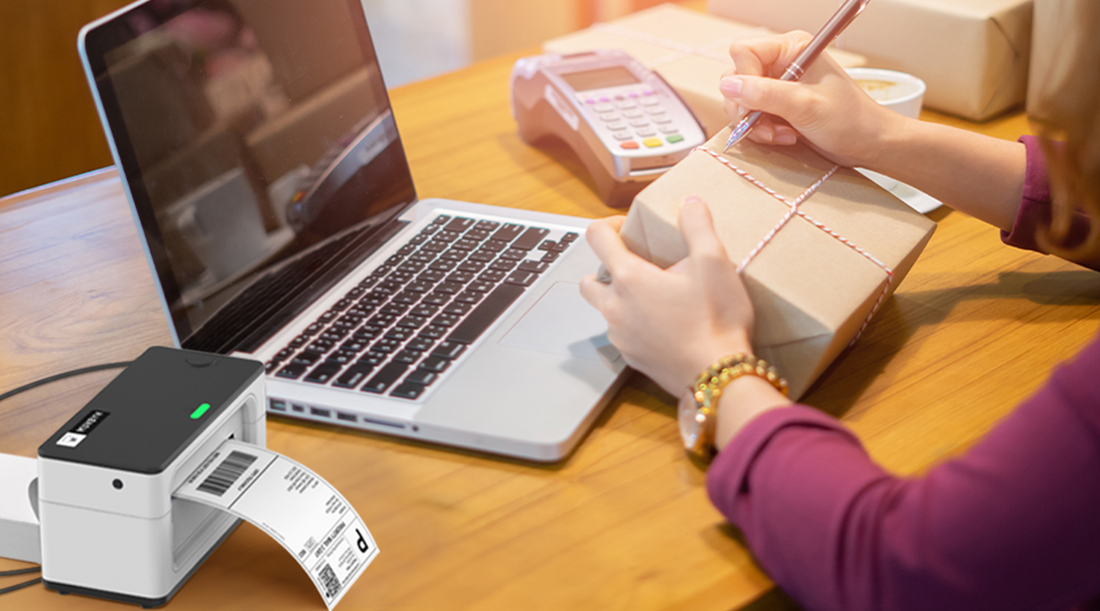Direct Thermal vs. Thermal Transfer: Which Is Better

Picking how to print your labels matters a lot. You've got two main choices: direct thermal and thermal transfer printing. They both have their good and not-so-good sides. Knowing what they're good at can help you decide which one is best for what you need. Let's dig into the important stuff to think about when you're trying to choose between these two ways of printing labels.
How does direct thermal printing work?
Direct thermal printing works like this: when heat touches a special chemical on the thermal label, it makes the chemical react and form the picture or words you want to print.
How does thermal transfer printing work?
Thermal transfer printing is a bit different. It uses heat and a ribbon. This ribbon goes through the printer and gets heated by a part called the print head. When the ribbon gets heated, the ink melts onto the label material, making the image or text you want to print.
Direct Thermal vs. Thermal Transfer: What is the difference?
Cost
Direct thermal labels cost around $9 to $12 for every 1000 labels, while thermal transfer labels range from $3 to $8 for the same quantity. The difference lies in the materials needed. Thermal transfer requires ribbons, which are priced between $9 and $18 per roll. One roll of ribbon can print about 2 to 3 rolls of labels. If you're printing around 2000 labels, the costs are quite similar between the two methods. However, if your printing needs go beyond that, the expense of thermal transfer starts to rise. Over the long term, printing more labels with thermal transfer becomes more costly compared to direct thermal printing.
Lifespan and durability
When we talk about how long labels last and how strong they are, direct thermal and thermal transfer have some differences. Direct thermal labels stick around for about 6 to 8 months before they might start to fade. They're good at staying waterproof and resistant to oil, but they can lose their color if they're under hot sun or heat. On the other hand, thermal transfer labels are more hardy – they can last up to 2 years. They can handle chemicals and stand up to heat, UV light, and water without getting ruined. So, if you want labels that stay tough for a longer time and can face different challenges, thermal transfer might be the way to go.
Applications
Direct thermal and thermal transfer printing each have their own special jobs. Direct thermal is great for things like shipping labels, QR codes, barcode labels, and receipts. It's good for quick stuff and things you only need for indoor and short-term(like up to 8 months). Thermal transfer is awesome for outdoor jobs because it can handle tough weather. It's really useful for keeping track of things like where stuff is located. And if you're dealing with really cold or freezing places, thermal transfer labels can handle it. So, depending on what you need labels for, you can pick direct thermal for simpler stuff or thermal transfer for tougher tasks.
Printing speed
Now let's talk about how fast these printers work. The direct thermal one, like the Munbyn 941U, can print 6 inches in just one second. On the other hand, the thermal transfer printer, like the Zebra GK420t, takes a bit longer at 5 inches per second. If you're printing a bunch, especially more than 10 shipping labels every day, the direct thermal printer is the winner. It's faster and gets things done quicker. So, for bigger printing jobs, the direct thermal printer is the better choice.
Components and maintenance
Direct thermal printers are pretty simple. They have fewer parts since they don't need ink, toner, or ribbons. Maintenance is easier because you mainly just need to clean the printhead now and then. Thermal transfer printers don’t have ink or toner either, but they do have to use ribbon, so there's a bit more to take care of. You'll need to change the ribbons regularly. Both printers need some care to keep them working well, but direct thermal is usually simpler to keep up.
Direct Thermal |
Thermal Transfer |
|
| Cost | cost-saving in the long run | ribbons add up supply cost |
| Lifespan | images or texts fade over six to eight months | images or texts last up to two years |
| Durability | water-proof and oil-proof, but can't withstand heat or sunlight | can handle chemicals and stand up to heat, UV light, and water |
| Printing speed | 6 inches/sec | 5 inches/sec |
| Component | no ink, toner, or ribbon | no ink or toner; uses ribbon |
| Printing quality | high-resolution | high-resolution |
Pros of direct thermal printing
- Simple setup and fewer components
- No need for ink, toner, or ribbons
- Print faster (can print up to 72 4x6 labels per minute)
- Ideal for indoor use under room temperature
- More cost-saving in the long run
- More environmental friendly compared to other printing methods, especially with the use of Munbyn BPA-free thermal labels
Cons of direct thermal printing
- Labels might fade in heat or sunlight
- Not ideal for challenging environment or outdoor use
- Only used for black and white printing (which is sufficient for shipping labels, barcode labels etc.)
Pros of thermal transfer printing
- Label can last longer
- More durable and can handle tough conditions
- Depending on the ribbon you use, you can produce full-color prints.
- Supports wider range of label materials
Cons of thermal transfer printing
- Require regular changing for ribbons and can add up supply cost
- Prints a bit slower than direct thermal
- Less eco-friendly since ribbons can lead to waste, unless they’re properly disposed
Which thermal printer should I choose?
When it comes to choosing the right printer, it depends on two aspects: How long do you want it to last, and in what applications do you use it? The images or text on direct thermal labels usually last six to eight months; they are best used for short-run label printing and barcode applications. They are often employed for shipping labels, receipts, address labels, thank-you stickers, etc. Additionally, they’re mostly used for indoor purposes, given that they aren't resistant to heat or sunlight.
On the other hand, thermal transfer labels can last up to two years, which makes them suitable for machine labeling, such as warehouse shelf labels or chemical labels.
If you’re running a small business at home or selling online, you probably mostly use the printer for shipping labels, barcode labels, thank-you stickers, etc. What you need is a label printer that prints fast, is cost-saving, and can generate high-resolution labels. In this case, a direct thermal printer is the way to go. Furthermore, you'll want to choose a high-quality label printer with a long-lasting printhead; Munbyn has got you covered. With our thermal label printer and BPA-free thermal labels, your printing process would be at ease.
You may also like:
MUNBYN vs Rollo Thermal Label Printer
How to Print a Perfect Shipping Label?



1 comment
Hello
I am looking for Transfer Thermal Label . i am also looking for pricing as well .